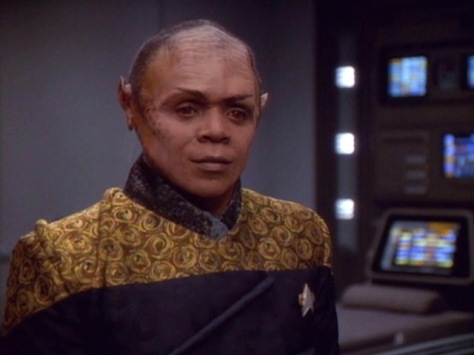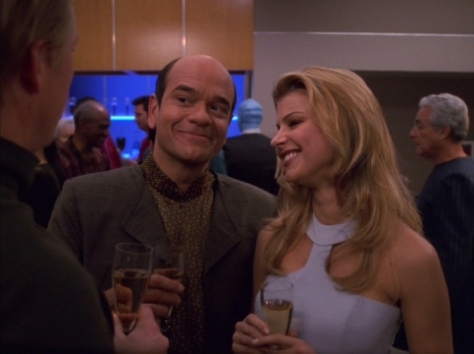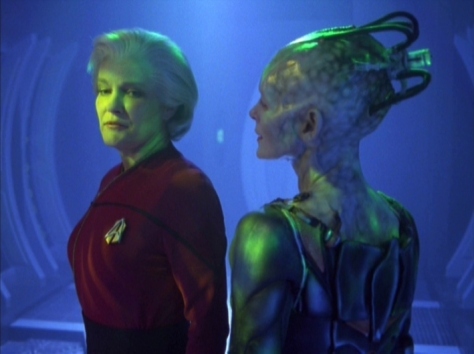Our 18-month mission to … tell you about Star Trek’s most pivotal episodes is (maybe?) over. We haven’t decided yet whether we’ll tackle the rebooted movies or the new series. But one thing’s for sure …
We still have a few things to say about Star Trek.
When we started this blog, we didn’t want it to be a site where we just reviewed every episode. Other sites, like Jammers Reviews, do that well enough. But now, as we close this project, we wanted to identify our 10 favorite episodes in all of Trek, including the movies. Some of these appeared in our Tapestry, others didn’t.
First, some honorable mentions: “Where No Man Has Gone Before,” “Mirror, Mirror”, “The Measure of a Man”, “Yesterday’s Enterprise”, “Improbable Cause”/”The Die is Cast”, “The Way of the Warrior”, “Timeless”, “Twilight”, “Star Trek III: The Search for Spock” and “Star Trek IV: The Voyage Home”.
Now, here’s our top 10. Note that this includes a couple of multipart stretches.

10. “Star Trek: First Contact” — Easily the best of the TNG movies. It’s gritty, visceral and still optimistic with a good supporting cast while being the only TNG film that feels all that consequential. The flawed Borg Queen concept is a slight ding — and it paved the way to defanging the Borg on Voyager — but it’s still a great film.
9. “Azati Prime”/ “Damage”/ “The Forgotten” — Enterprise’s peak in arguably the most daring, and probably the most morally questionable, stretch of Trek episodes, which worked well in the years immediately following 9/11. It’s not Roddenberry’s Trek, but it’s good TV and as edgy as anything the franchise did.
9. “The Trouble with Tribbles” — Trek’s best comedy and also an episode that shows why TOS endures: the chemistry among the cast members. Kirk dressing down Scotty and others for getting in a fight with Klingons is still a thing of beauty.
7. “In the Pale Moonlight” — The episode where DS9 decided to not even pretend to be like the rest of Star Trek. It’s controversial as it makes Sisko, in effect, a criminal, which was just incredibly daring for 1998 TV. It might have been higher on the list if the scope issues that DS9 struggled with — i.e., a handful of people on the station can change and have no problem with changing the balance of galactic affairs — had been better handled.
6. “The City on the Edge of Forever” — Many fans’ favorite, but not ours. Arguably, it had been built up too much by the time we saw it and wasn’t as original in the 1990s as it was in the 1960s. Still, a great episode with Shatner, Nimoy and Kelley absolutely bringing it.

5. “Star Trek II: The Wrath of Khan” — Trek’s best film. Shatner and Nimoy are pitch-perfect and the story is a great mix of action and science fiction. If you haven’t seen it, you’re not really a Trek fan.
4. “The Inner Light” — Simply an amazing episode in which Picard lives an entirely different life as a way for a dying civilization to not be forgotten. The final scene with Picard in his quarters, as he re-acclimates with his real life, is a gut punch in the best way. It’s unfortunate that we didn’t see more consequences in subsequent episodes and that Picard, more or less, is back in regular form the next week.
3. “The Visitor” — DS9’s finest episode as Sisko is lost and Jake spends the rest of his life trying to find him. We were often critical of Avery Brooks, but he was absolutely great in this episode. As poignant as Trek gets.
2. “Space Seed” — The setup to the second film is incredible to watch. That it was on television in 1967 is amazing, as Khan’s manipulation of Lt. McGivers is very edgy and provocative. Kirk’s decision to let Khan try to build a world rather than putting him in prison is classic TOS, in that it’s morally justifiable and intellectually curious but also a dangerous and questionable call.

1. “The Best of Both Worlds” — No surprise here. This two-parter has everything, and set the stage for cliffhangers for the next 25 years. Jonathan Frakes — often marginalized in late TNG — puts in his best performance and the Borg, as an implacable threat, still seem menacing today. Even the scene where Riker chooses his first officer is great. I would go as far as saying it’s a perfect two-parter, except for the somewhat rushed ending. It’s also bolstered by the idea that Picard wasn’t back at his desk the following week. In fact, he struggled with his experiences immediately after he’s rescued and in the following years.
And now, the bottom 10 (after some dishonorable mentions): “The Alternative Factor”, “The Lights of Zetar”, “Haven”, “Dark Page”, “Star Trek: Insurrection”, “Ferengi Love Songs”, “Spirit Folk”, “The Disease”, “Precious Cargo”, “Extinction”.

10. “Star Trek V: The Final Frontier” — The strangest entry in the film franchise. It’s light and jokey at points and heavy and ponderous at others — but it consistently avoids anything approaching subtlety. Co-written by William Shatner, the movie seems intent on lionizing Kirk while painting Spock as weak and evasive (the scene in the brig being the worst example). Worse, the script humiliates Scotty and Uhura.
9. “Course: Oblivion” — One of a handful of episodes that shows exactly what was wrong with Voyager. Instead of using a strong cast and a great concept to write compelling stuff with the REAL Voyager, the creators used those things with a FAKE Voyager. Worse, the fake Voyager should have easily known that it was a fake Voyager, invalidating the whole premise of the episode. And how did the fake Voyager crew build a fake Voyager and survive for like a year outside of the only environment that could support it?
8. “Code of Honor” — Weirdly racist and definitely uninspired. It feels more like third-season TOS than TNG, which sort of makes sense, as it was just the third TNG episode. Still, it’s hard to understand what the creators were thinking.

7. “Shades of Gray” — The awful Riker flashback episode partly necessitated by a writers’ strike. Yuck.
6. “Profit and Lace” — The worst of DS9’s awful Ferengi episodes. Quark in drag? What drivel. DS9’s obsession with having two Ferengi-centric episodes a year was just ridiculous.
5. “Fascination” — Lwaxana Troi comes to DS9 and everybody — well, at least the main cast and the regular guest stars, minus Sisko — gets horny. WTF, creators?
4. “Threshold” — The most scientifically awful episode in second-generation Trek. It didn’t make the top spot because there’s SOME good work by Robert Duncan-McNeil and it was an attempt at something new and different.
3. “A Night in Sickbay” — Archer as a total huffy asshole, with moronic aliens and a ceremonial apology involving a chainsaw. Oh, and a totally unnecessary sexual fantasy from Archer about T’Pol. The Archer/T’Pol relationship — at least in the prime reality — was professional and friendly, not romantic. Throwing a sex dream from Archer in there really belittled the show.
And, we have a tie for Trek’s worst episode:

1. “And the Children Shall Lead” — Wow. What an absolute train wreck. The kids are annoying and awful, the villain behind their behavior is horribly acted and conceived and even the editing is bad. While “Spock’s Brain” and “The Way to Eden” are the most infamous episodes of TOS, “And the Children Shall Lead” is BY FAR the worst.

1. “Sub Rosa” — Of all the awfulness in TNG’s seventh season — it’s worse than season one, folks, as the creators should have known better after six-plus years of the series — this episode is just cringe-worthy. Crusher was the most neglected of the TNG regulars, and it’s a shame that one of the few episodes to feature her is this hideous mess. She falls in love … with a freaking ghost.
That’s it for Trek Tapestry.
Or is it …
















